We occasionally link to goods offered by vendors to help the reader find relevant products. Some of these may be affiliate based, meaning we earn small commissions (at no additional cost to you) if items are purchased. Here is more about what we do.
Well, there aren’t many kitchen gadgets that have a ballet written for them, are there? It seems the nutcracker is the only one that can make such a claim to fame.
Of course, that was a much fancier nutcracker than what most of us have in our kitchens. Both collectible and functional, these clever devices have a vast and interesting history that reflects mythology, social commentary and political satire – as well as hulling the sweet kernels of various types of nuts.
With a sense of whimsy, the collectible versions of these unique gadgets appeal to the imagination and can cost several hundred dollars. As a functional tool, they’ve taken on many shapes throughout the ages. All so we can get at those tasty nut kernels that we all love, of course.
[one-half-first]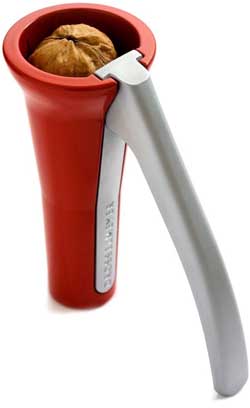 .[/one-half-first]
.[/one-half-first]
[one-half]
Foodal’s Number 1 Pick
This well engineered device from Sweden device makes shelling nuts easy, and it’s great for those with joint pain.

Or See Our Full Review Below[/one-half]
So, let’s take a brief look at the evolution of one of our first pieces of kitchenalia, some points to consider for today’s nut-cracking enjoyment, and our recommendations based on functionality, ease of use, aesthetics and cost.
A Bit of History
In both North America and Europe, archeologists have found evidence for hulling these shell-bound fruits and seeds: cracking pestles, smooth stones rounded on both ends along with cupped stones for holding the kernels that our nomadic ancestors used thousands of years ago, dating from 2,000-6,000 BC.
Apparently these hunter-gatherers would camp out under the fruit laden trees, and as they ripened, would gather the nuts to eat raw, as well as making a crude butter paste for cooking.
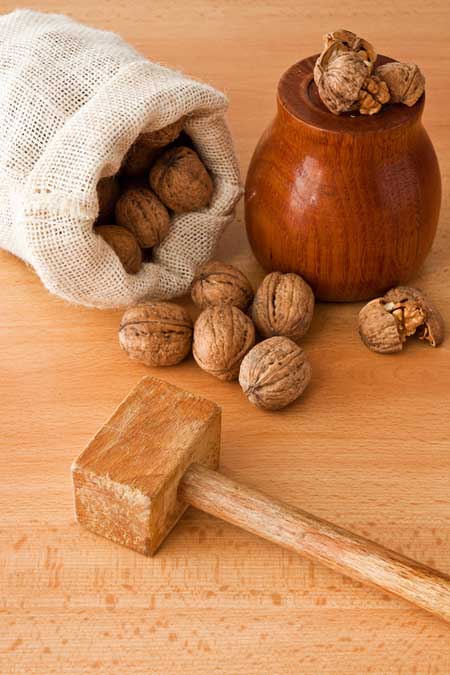
Not much seems to have changed in our shell-busting technology until around 500 BC, when it’s rumored that Aristotle owned a set of leather hinged crackers for opening sweetmeats. The town of Leavenworth in Washington boasts a pair in their museum dating from Roman times, approximately 200 BC-200 AD. And the Ironwork Museum in Rouen, France has a set of iron plier-style crackers from the 13th century.
The earliest written reference to mechanical shelling is found in Chaucer’s Canterbury Tales, written at the end of the 1300s. After this time period, production seemed to increase considerably, with numerous brass sets from the 14th and 15th centuries being discovered, which are now on display in various museums. Hand tooled at first, these metal sets were later crafted using molds in a forge.
[one-half-first][/one-half-first]
[one-half]
The Best For Walnuts
This heavy duty, made in USA model smashes though black walnuts like a knife through hot butter – buy this one for effortless shelling.
Or See Our Full Review Below[/one-half]
Wooden cracking implements first appeared on the scene during the 15th and 16th centuries in England, France and Germany and quickly became an art form in their own right. They were hand turned and beautifully carved in the form of animals, people and birds – totems to protect the home, with big wooden teeth to scare off evil spirits, and to usher in good luck.
Later, authority figures such as kings, mayors and leaders of industry were caricatured in the carvings. It was a safe way to poke fun at the upper crust of society and to have the lords “serve” the commoners by cracking their nuts.
During this time, elaborate and ornamental hulling tools came into vogue, a status symbol of the elite who would linger after dinner enjoying a dessert of sweetmeats – walnuts, pecans and hazelnuts.
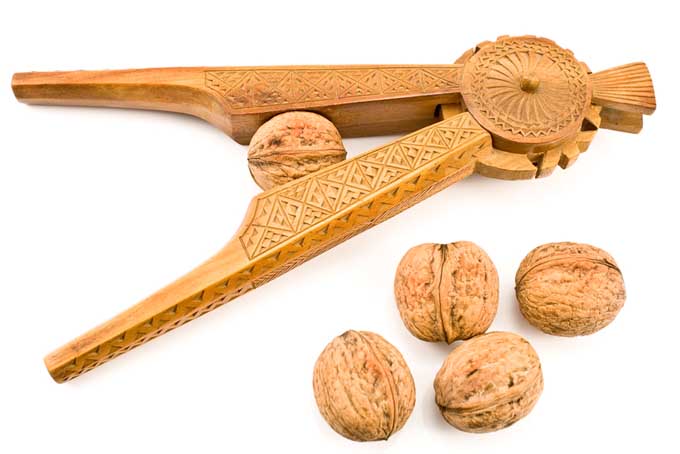
Wooden screw-style nutcrackers first appeared in the 17th century in the Alpine regions of Europe, initially simple in design but soon taking on intricate detailing. Tall freestanding figurines, often in the forms of kings and soldiers, appearad in Germany in the early 1800s and became the grist for fairy tales, with the Brothers Grimm adding the term “nussknacker” to their vocabulary in 1830.
Storyteller E.T.A. Hoffman’s tale of “The Nutcracker and Mouse King” inspired Tchaikovsky to write the famed Nutcracker Suite, a beloved Christmas favorite and beloved ballet, to this day.
It was first performed in the US by the San Francisco Ballet in 1944, with great success. And its popularity coincided with the subsequent occupation of Germany by US troops after WWII, where GIs found a variety of similar nutcrackers in village markets, and bought the colorful gizmos home as souvenirs and gifts. In turn, this led to an increase in the desire for stylized ornamental cracking devices among collectors.
We’ve certainly come a long way since bashing shells with a stone was common practice.
Types and Styles
Today’s nut hullers come in a few basic styles:
- The Single Lever: where the kernel is placed on a stationary surface and a lever is employed to crack it open.
- The Pliers Style or V-Shaped: made of two arms of equal length with the pivot point being at the apex of both arms.
- The Turn-Screw: where the intact shell is placed in a cup or holder and a screw is turned until a block cracks it open.
- The Percussion Style: where the hull of the kernel is held stationary while a weight hits it with enough force to break it open.
What to Look For
- Finger safety. If you’ve ever pinched your fingers with the straight-armed, pliers style of cracker, you know how much it hurts. Look for tools that have curved arms or a block below the teeth to prevent pinching.
- Comfort. Narrow handles concentrate the energy into a small area, which can cause stress and hand pain if cracking a lot of shells. Look for wider handles with non-slip grips for greater comfort. Or for those with weaker hands or arthritis, consider a turn-screw or lever action shelling device.
- Capacity. If you’re planning on hulling a lot of nuts, a table-top lever action splitter may be a better option than the V-shaped ones.
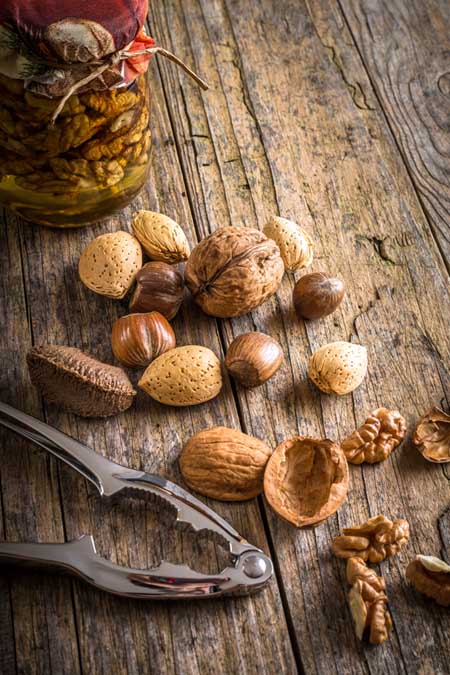
- Size.With the hybridization of trees, edible seeds grow bigger than they once did. Ensure that the cavity or teeth of the utensil will accommodate nutritious nuggets of all shapes and sizes.
- Function vs. decoration. If your huller is intended for use as a tool, ornamental or decorative shelling gadgets may not serve the purpose very well.
- Storage. If space is at a premium in your kitchen, consideration should be given to where it will be stored. Most V-shaped plier types can be stored in a drawer, but tabletop versions will need cupboard or shelf space.
- Cost. As shelling utensils come in a wide range of prices, determine what price point will suit your budget.
- Durability. Pins and screws can come loose with use, and cast aluminum can break. Crackers made of plastic and resin are also known to split when cracking the tougher shells, such as macadamias.
Here are our recommendations:
Handheld Crackers
 The Drosselmeyer
The Drosselmeyer
With the typical efficient Swedish design, the Drosselmeyer is touted as the only handheld cracker with a patented double lever action, which reduces the energy expended by 80% for maximum ergonomic comfort. All three of the pieces fit together without pins or screws, so there’s nothing that can come loose when applying pressure.
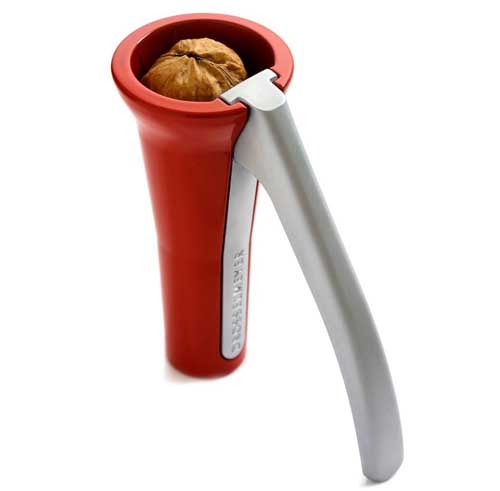
The Drosselmeyer Nutcracker available on Amazon
The sheller is designed so that the nut drops into the elongated cup, collecting the meat and shells for a clean, mess free-hulling experience. It’s also small enough to store easily.
Made of zinc in Sweden, this handsome utensil is available in red, black or grey and also seems to be a popular gift item. It comes with a lifetime warranty on the lever.
Several of the reviews on Amazon are from those with arthritis or other hand strength issues that can make cracking nuts difficult and painful – but not so with the Drosselmeyer, as the squeeze handle is extremely energy efficient for those with a weak grip.
A bit on the expensive side for a non-decorative functional sheller, customers who have made the purchase all seem to agree that this sheller is well work the price.
The Alessi
Made of stainless steel in Italy, this set of plier-style shell splitters has sleek, modern lines, created by well-known designer Alessandro Mendini.
Weighing in at a hefty 2.45 pounds, the well balanced, strong arms with wide handle stations flip over in a reversible action to accommodate a variety of hull shapes – small, medium or large shells will all fit in these crackers.
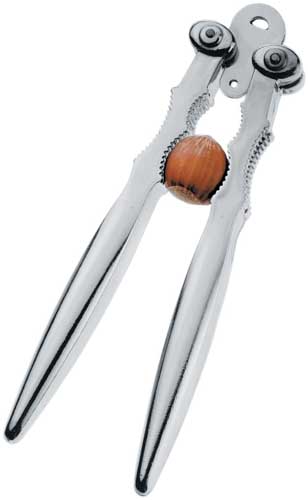
The Alessandro Mendini Crack Nutcracker available on Amazon
Very distinctive and contemporary in appearance, and constructed with high quality Italian craftsmanship, they also come with a 2-year warranty and are compact enough for easy drawer storage.
The only apparent problems with these shellers are the expensive designer price tag, and the potential for finger pinching because of the minimalist straight-arm design.
Oxo Good Grips
This sleek set of “no-nonsense” crackers seems to have all the bases covered.
Economical with a good solid weight and balance, they have the strength to crack larger sized kernels as well as smaller ones, with the added bonus that they may serve double duty cracking lobster and crab claws. This is thanks to a long mouth section with strong metal teeth. The surface of the wide handles has non-slip rubber grips that are comfortable to use, and that absorb the exerted pressure evenly.
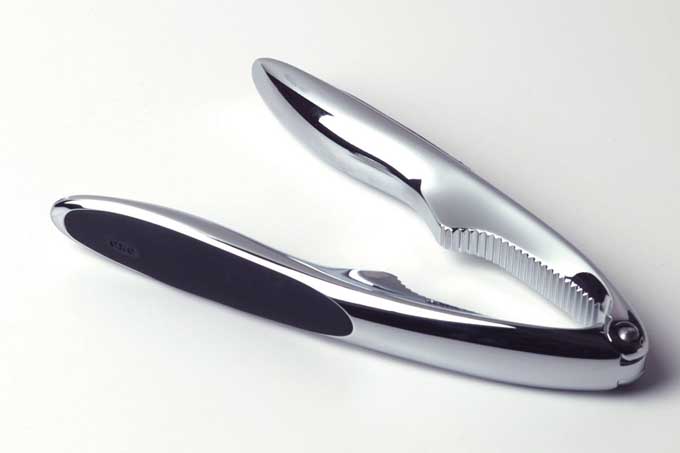
They also provide the necessary leverage to split the toughest of shells, and the arms won’t pinch your fingers when cracking smaller sized hulls because of the block below the metal teeth. They’re efficient and powerful with a substantial heft, so that the lever action is doing the work rather than your hands. With a polished zinc finish, they have attractive style lines and will store easily in any kitchen drawer.
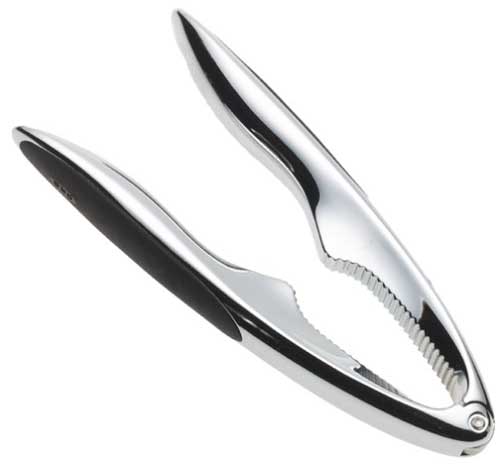
OXO Good Grips Slim Nut/Seafood Cracker
However, they do have a couple of drawbacks worth noting. Because of their open design, the shells tend to go flying. You can cup one hand over the nut, but they still seem to cause a bit of a mess. And a few comments have been made on Amazon regarding the screw at the pivot point being loose or flimsy, while others have had no problems with the screw.
These crackers are made of polished zinc in the China, and OXO usually has exceptional quality control, but it seems a few managed to slip through the cracks with this product.
The Burstenhaus Redecker Cracker
Crafted in Germany, this handsome tool is made of heavy-duty cast aluminum, with beechwood handles for better grip and twisting action, and two-handed application of pressure – which has a lot of appeal if hand strength is an issue.
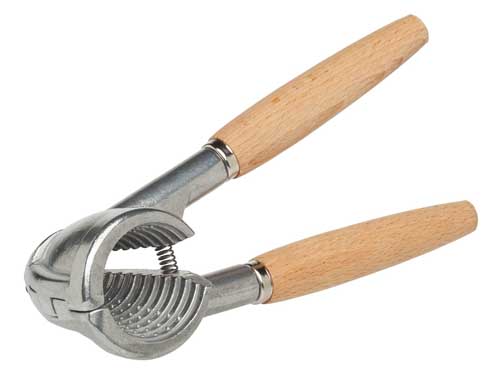
Bürstenhaus Redecker Aluminum Nut Cracker with Beechwood Handle
The large cup is good for cracking all sizes of kernels and it catches the shells, so clean up is minimal. And the strong spring ensures that the handles won’t pinch. Its unique ridged interior can also be used for opening champagne bottles – always a bonus!
There have been a couple of reported problems with the handles, with one reviewer complaining of a loose handle and another explaining that the handle had cracked, so perhaps this material isn’t the best for the leverage exerted.
Lever Style Nut Crackers
 The Get Crackin’
The Get Crackin’
Well, this steel lever-action tabletop tool isn’t going to win any awards for stylish design, but it does seem to get the job done, if you have a large volume of shells to get through. The long handle gives extra leverage, and the gear placement won’t crush the sweetmeat by cracking too far.
Sturdy and rugged, weighing 4 pounds and constructed of hand-welded 1/8” and 3/16” steel, this shell cracker is built to last. With an industrial theme and look, this made in the USA machine is great for cracking hard shells in quantity, and also comes with a one-year warranty.
The Get Crackin’ Nut Cracker available on Amazon
Because of its size and design, this sheller needs a sturdy surface to sit on and will storage space in a cupboard. It creates a mess of broken shells whenever it’s used, and perhaps would be most appropriate on a work bench or outdoors, if you plan on doing a lot of shelling. Given its extreme durability, the higher price range seems reasonable if it lasts as long as the manufacturer claims.
Duke’s Heavy Duty Pecan Opener
Another tabletop lever-action shell opener, this model isn’t quite as industrial in design or construction as the one above. With a long vintage hand lever designed for extra leverage, this shell opener also has an adjustable threaded cone for adapting to different kernel sizes, and the lever shuttles the press backwards onto the nut.
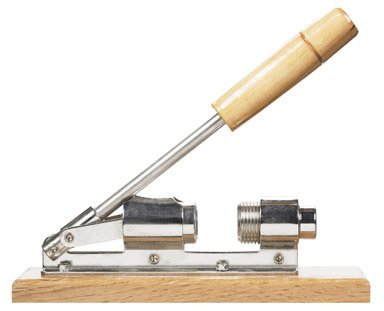
Duke’s Easy Pecan and Nut Cracker
This device works well on nuts of all sizes, and the solid construction gets the job done for large or small amounts of shelling.
The main complaint seems to be about the mess of shells it creates, so the kitchen table might be the best spot for using this pecan and walnut opener. However, this is an inexpensive device that can get you started.Check Amazon for the current price (it fluctuates).
Screw Style
European Wood Nut Cracker and Bowl Set
Shaped like a forest mushroom, this attractive nut cracker and bowl is made in Poland of FSC sustainable beechwood. With a unique screw action and wide palm cap for easy gripping, the nut cavity will collect most of the shells and it has a pinch-free design.
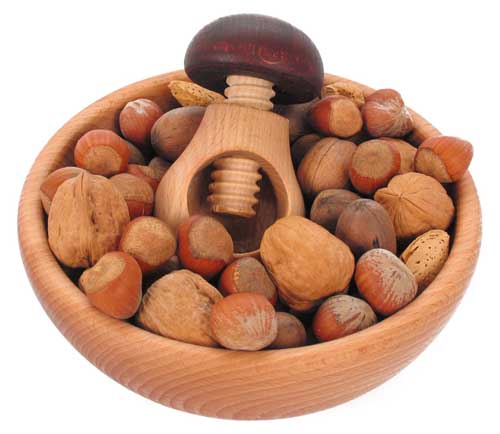
European Wood Nutcracker & Bowl Gift Set
Easy to use and good for cracking all sizes of nuts, the 7” wide bowl is carved from one piece of wood with a natural oiled finish, making a beautiful set. Perfect for casual entertaining, this set is attractive and functional, and would look great on a coffee table.
And there you have our suggestions for your nut cracking needs. From economical to high end, and heavy duty to decorative, there’s a nutcracker out there to suit all occasions – so, get cracking!
First published May 16th, 2015. Last updated January 10th, 2020.
About Lorna Kring
Recently retired as a costume specialist in the TV and film industry, Lorna now enjoys blogging on contemporary lifestyle themes. A bit daft about the garden, she’s particularly obsessed with organic tomatoes and herbs, and delights in breaking bread with family and friends.

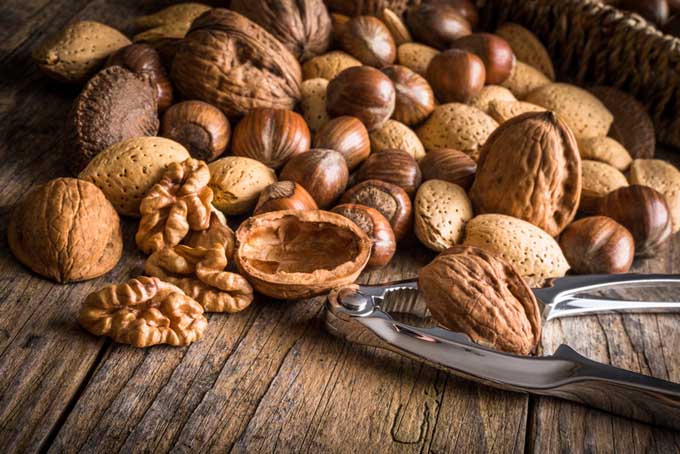
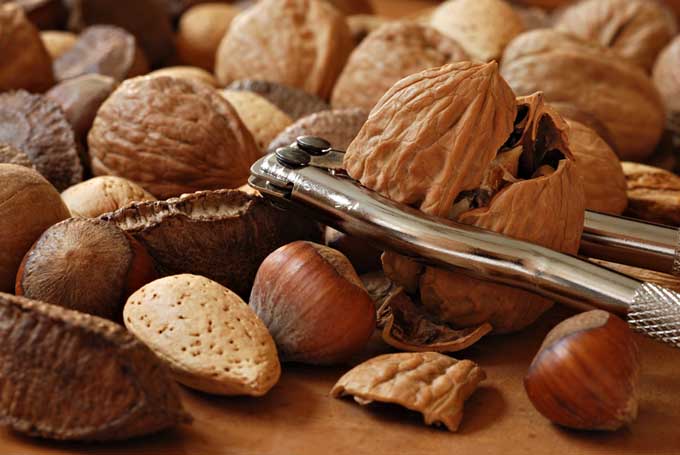
 The Drosselmeyer
The Drosselmeyer



I’m surprised the classic Nutcracker Man did not grace the list. Sure he’s difficult to manage & makes a mess but so does my guy & I still keep him around!
But seriously, I really enjoy the European crank nutcracker. I’ve had one for a long time now & still bring it out for parties. Want to have a good time? Stand there while people quizzically look at it & either try or grab a cracker with cheese next to it.
LOL! That’s good Joan. People watching when a new gadget’s involved is pretty entertaining… they either go for it, or use the avoidance technique of going for the crackers and cheese. Hopefully at some point you enlighten them!
I have several sets, but I have an issue with them slipping out of my hand. I have arthritis, carpal tunnel, tendinitis, and tendinosis, so doing things like cracking nuts is a real chore. There are several here that I’m interested in, for different reasons. Eventually, perhaps I can get a tabletop model, but for now, I think I will swap out my current ones for the OXO Good Grips crackers with the rubber grips. The grips should prevent the crackers(and nuts) from flying out of my hands, thereby decreasing the chance that I’ll injure someone nearby.
There was a number of favorable comments about the comfort of the OXO Good Grips, particularly from folks with strength and flexibility issues in their hands. If you do get a set, let us know how they work for you…
I remember back in the day, my cousin and I trying so hard to crack those pistachios off their hard layer… hammering away, spoiling the floor, the table tops to the point of looking for something easier and less tiresome to preoccupy our minds thereby leaving the mess intact to the outbursts of my aunt in the evening and some punishment would surely follow 🙁 … good old days 🙂
I’ll definitely keep this article in mind next time am off shopping for some nutcrackers 🙂
Good old days indeed. Cracking nuts to get to the treasure inside does seem to have a particular fascination for kids… regardless of the consequences!
Wow, I wasn’t aware that there is such a diversity of nutcracker brands and types these days. I used to love opening nuts as a kid, and even as an adult it gives me a strange sense of pleasure and satisfaction when I start cracking them up with a good handle, haha.
It’s a fun pastime, and for many, has lots of fond memories! And as you say, strangely satisfying…
I must be to lazy to need a nutcracker. i always buy shelled. The only exception pistachios which I don’t really need a tool for anyway.
Shelled are certainly convenient, but cracking your own will slow down consumption a bit… it’s so easy to over-indulge!
Decided to read this article just for fun and maybe learn a little history, but after reading this article and looking at reviews, I really want that Drosselmeyer nut cracker. I know it’s out of my budget, but that little device sounds awesome. I love the design of it and the functionality of it sounds awesome too. I’ll just have to stay on the look out for any sales.
It’s pretty cool for a nutcracker altmom5… trust the Swedes to come up with such a modern design! Hope you find it on sale sometime.
The pliers style of nutcracker seems to be the most intuitive and easy to use design for me. I’ve used a trusty stainless steel one for as long as I can remember, the wooden ones seem a bit too light and flimsy for my liking.
The pliers style is the old standby – hard to improve on something so simple and efficient!
I love raw nuts, but cracking them has always been such a hassle. Thank you so much for this guide. Before I read this, I never actually considered one nutcracker might be better than another – I never even realized there were so many nutcrackers to choose from! I certainly have my work cutout for me now.
It’s pretty amazing how many options there actually are tomservo. Good luck making a choice!
Wow! I loved the carved antique nutcracker. I would like to buy one of those even if they do not crack many varieties of nuts. Do you think they still sell wooden variations of nutcrackers anywhere in London?
He’s a beauty! It’s been a few years since I’ve been in London lecitia, but I bet some of those great collectables shops on Portobello Road or Chelsea would have some vintage ones. For modern versions, Christmas shops are always a good option. Good luck with your search!
Forty years ago my father always bought bags and bags of nuts at Christmastime, he loved them. He never ever used anything but a pair of mole grips to crack them, adjustable so not to crush the nut too, easy to use as the torque is multiplied so no red faces with tough nuts, and forty years later I have found nothing at all that does a better, more controlled job!!!!
Haha, nothing like a simple pair of vice grips… thanks Steve!
Some really choice posts on this website, saved to favorites.
Thanks for all the great info. Which would be your best recommendation for home use to crack heart nuts and black walnuts. They are terrifically hard!
Carol
I wanted to buy a USA nutcracker and was disappointed regarding the only one mentioned. At least you have other options besides Chinese though.